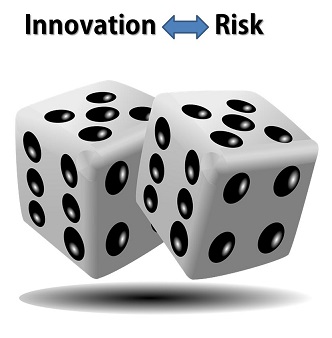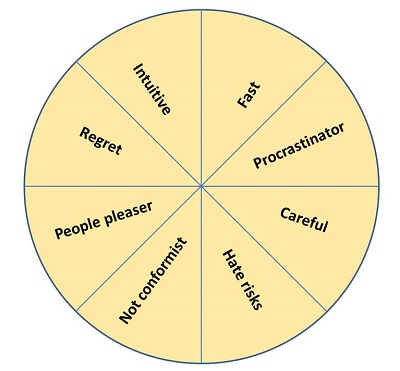


To initiate and be proactive, you have to take risks, but unlike gambling, the chances that the entrepreneur takes are calculated risks.
We can find ourselves forced to take risks, even if we succeeded in avoiding them all our lives.
Taking risks in starting a new business, especially at an elderly age, when an entrepreneur has the responsibility to support his/her family, is becoming more complex.
In our times, in Israel and across the globe, we found that people aged 45+ often find themselves unable to get hired as employees, and as a result, are forced to start their own businesses.
When starting a business, the ability to analyze risks and assess the probability of success against the chances of failure is extremely important.
An article in the Globes newspaper was published with the headline: 'The Next Poor People are Ex-High Tech.' The article described how people use their entire savings to start a business and are left with nothing.

This article illustrates how important it is that everyone, even those who now feel safe in their workplace, learn the business development process, which includes the preparation of a business and marketing plan, studying the business feasibility, and assessing risks.
The more a person is prepared for this stage of life when he/she is setting up a business, the better. Nowadays, sooner or later, he/she may need to recalculate his/her path. Doing so will increase one's chances of success. Often the entrepreneur will consider a mix of factors, both personal and environmental, when evaluating the viability of the venture.
In one of Galit Zamler's entrepreneur classes, one of the students told about her grandfather, who, after many years of working as an employee, retired, and decided to invest his savings in starting an electrical products business.
According to the student, her grandfather had to close his business after six months and lost all his savings as a result. Today, her father, who is the son of that grandfather, has to support his father financially.
The student concluded that being an entrepreneur is not worth it. She came to this conclusion after seeing an entrepreneur, who she is very close to, fail.
However, according to Galit, the conclusion should be different. Entrepreneurship is a good thing. Galit believes that entrepreneurship enables people to fulfill their full potential and feel satisfaction. It is important to note that entrepreneurship is also involving risks. We must consider that the venture might fail. We need to be aware of the fact that most startups fail.
Once we take into account that a project may fail, we take a calculated risk. Calculated risks are risks that we can take even if we fail.
Indeed, there are people willing to risk everything, and some even succeed, in doing so, but one has to see the overall picture in mind and only then make a decision.
The Entrepreneur:
An entrepreneur takes a risk by simply deciding to start an enterprise. However, unlike a bet in which one's ability to affect the outcome is zero, when an entrepreneur takes risks in setting up a venture, he/she calculates his/her chances of succeeding or failing and chooses from a discretionary to continue with his/her dream and work for its success.
Throughout the entire entrepreneurial process, the entrepreneur has to make many decisions in different fields. Some of them have a significant effect on the continuation of his/her activity.
An entrepreneur operates in a changing environment, and sometimes he/she has to make quick decisions and while under pressure. Many times he/she does not stick to what he/she already knows. An entrepreneur is ready to change when necessary and understands that sometimes investments should be discarded in favor of better, new directions. These are often painful decisions, but entrepreneurs often know how to make such decisions.
An example of an Entrepreneur:
Israeli entrepreneur Stef Wertheimer described the beginning of his entrepreneurial experience in his book "The Habit of Labor":
"It was a difficult decision to leave a steady job. It was a decision that involved giving up a safe salary as well as high status and going back to manual labor next to the machine. This was the first step in the realization of a dream which seemed so entirely imaginary. However, that didn't deter me."
Yossi Yassur, in his book "Did You also have no Hot Water? A Guide to Preventing failures in Decision-Making," wrote:
"In business and life, in general, taking risks is essential to success. But taking risks isn't a gamble. Taking risks is the act of choosing an uncertain decision with headlight high income over a certain decision with headlight low income.
There is a key difference between taking a gamble and taking a risk. Gambling is a decision made against the odds, while risk-taking is a decision that goes with the odds."
In a session on innovation, risk, and brainstorming of the Entrepreneurship for Kids Program, children learn that invention alone is not innovation and that there is a connection between innovation and risk. They learn that innovation is not a gamble, but rather a calculated risk.

The way of making decisions in different situations and different areas, changes from entrepreneur to entrepreneur and from venture to venture, but it is worthwhile for the entrepreneur to be aware of how he/she and his/her colleagues make decisions. That awareness will assist him/her to see things from a different angle and maybe make decisions differently.

Test yourself, what kind of decision-maker are you?
Fast - Make decisions quickly
Procrastinator - Avoid the decision making to the last possible moment
Careful - Look for as much information as possible before making decisions
Hate risks - Prefer to make risk-free decisions
Nonconformist - Make decisions that are different from those that others make
People pleaser - Make decisions that make other people happy, and not necessarily you
Regret - Tend to regret the decisions made and therefore change positions often
Intuitive - Make decisions based on gut feeling

As parents and educators, we should allow children to take controlled risks, which will enable them to cope with daring, to calculate the degree of risk versus chance, to emotionally cope with the feeling of risk. And to know to assess their ability to handle the situation.
This means small risks, that don't endanger the children but challenge them. Such risk-taking is important for building a sense of competence, for building personal resilience, for the capability of making decisions, for independent and critical thinking, and for empowering children.
Taking risks in that way teaches children to reevaluate their abilities every time, which will be improved over time.
Therefore, even if there's a certain doubt in our hearts, we must allow kids to climb trees, balance above great heights, swing high, run, fall, use our work tools, etc.

Many studies have shown that people are tending to regret mostly for things that they didn't do. Hence, it seems that somewhere in each of us lies the desire to do and act, lest we will regret not doing.
In order not to find ourselves regretting not fulfilling our wishes and dreams, we must make informed decisions and act accordingly.
The studies have also shown that if we are making a decision and acting according to it, but in the end failing, we accept it better than if we didn't try at all. The feeling is one of wholeness because at least we tried.

The entrepreneurial process involves many challenges, and entrepreneurs invest significant efforts in promoting their ideas to success.
But sometimes, it's also essential to know when to stop. This can be for many and varied reasons, such as competitors who have a relative advantage over our venture, inability to find an economic model that justifies continued development, and more.
The decision to stop is not at all simple, especially after so much effort has already been invested. Sometimes, it's difficult to stop because we've created expectations for ourselves and our environment that we will eventually succeed.
It's a courageous decision. No less courageous than developing an idea in the first place.
Practical people also know how to make decisions of this kind.